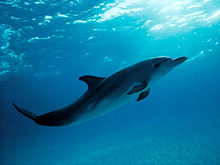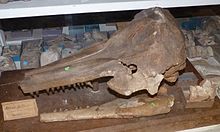Oceanic dolphin
| Oceanic dolphin Temporal range:
| |
|---|---|

| |
| Pacific white-sided dolphins | |
| Scientific classification | |
| Kingdom: | |
| Phylum: | |
| Class: | |
| Order: | |
| Suborder: | |
| Superfamily: | |
| Family: | Delphinidae Gray, 1821
|
| Genera | |
|
See text. | |
Oceanic dolphins are members of the cetacean family Delphinidae. Delphinidae is the largest family of cetaceans, with more than 30 species as members. These small toothed whales are found worldwide, mostly in the shallower seas of the continental shelves. As the name implies, oceanic dolphins tend to be found in the open seas, unlike the river dolphins, although a few species such as the Irrawaddy dolphin are coastal or riverine.
Six of the larger species in the Delphinidae, the Orca, Pilot (Long-finned and Short-finned), Melon-headed, Pygmy killer and False killer whales, are despite their names, dolphins, and are also sometimes collectively known as "blackfish". [1] (but dolphins are of course not fish but marine mammals).
Characteristics

The Delphinidae are the most diverse of the cetacean families, with numerous variations between species. They range in size from 1.2 m (3.9 ft) and 40 kg (88 lb) (Haviside's dolphin), to 9 m (30 ft) and 10 tonnes (Killer whale). Most species weigh between 50 and 200 kg (110 and 440 lb). They typically have curved dorsal fins, clear 'beaks' at the front of their heads, and forehead melons, although exceptions to all of these rules are found. They have a wide range of colors and patterns.[2]
Delphinids, especially bottlenose dolphins, are able to hybridize with a wide variety of other delphinid species, wolphins are just one those many possible hybrids. [3]
Most delphinids primarily eat fish, along with a smaller number of squid and small crustaceans, but some species specialise in eating squid, or, in the case of the killer whale, also eat marine mammals and birds. All, however, are purely carnivorous. They typically have between 100 and 200 teeth, although a few species have considerably fewer.
Delphinids travel in large pods, which may number a thousand individuals in some species. Each pod forages over a range of a few dozen to a few hundred square miles. Some pods have a loose social structure, with individuals frequently joining or leaving, but others seem to be more permanent, perhaps dominated by a male and a harem of females.[2] Individuals communicate by sound, producing low-frequency whistles, and also produce high-frequency broadband clicks of 80-220 kHz, which are primarily used for echolocation. Gestation lasts from 10 to 18 months, and results in the birth of a single calf.
Taxonomy

- Suborder Odontoceti
- Superfamily Delphinoidea
- Family Delphinidae
- Genus Peponocephala
- Melon-headed whale, Peponocephala electra
- Genus Orcinus
- Killer whale (orca), Orcinus orca
- Orcinus citoniensis †
- Genus Feresa
- Pygmy killer whale, Feresa attenuata
- Genus Pseudorca
- False killer whale, Pseudorca crassidens
- Genus Globicephala
- Long-finned pilot whale, Globicephala melas
- Short-finned pilot whale, Globicephala macrorhynchus
- Genus Delphinus
- Long-beaked common dolphin, Delphinus capensis
- Short-beaked common dolphin, Delphinus delphis
- Genus Lissodelphis
- Northern right whale dolphin, Lissodelphis borealis
- Southern right whale dolphin, Lissodelphis peronii
- Genus Sotalia
- Genus Sousa
- Pacific humpback dolphin, Sousa chinensis
- Indian humpback dolphin, Sousa plumbea
- Atlantic humpback dolphin, Sousa teuszii
- Genus Stenella
- Atlantic spotted dolphin, Stenella frontalis
- Clymene dolphin, Stenella clymene
- Pantropical spotted dolphin, Stenella attenuata
- Spinner dolphin, Stenella longirostris
- Striped dolphin, Stenella coeruleoalba
- Genus Steno
- Rough-toothed dolphin, Steno bredanensis
- Genus Tursiops
- Common bottlenose dolphin, Tursiops truncatus
- Indo-Pacific bottlenose dolphin, Tursiops aduncus
- Burrunan dolphin, Tursiops australis
- Genus Cephalorhynchus
- Chilean dolphin, Cephalorhynchus eutropia
- Commerson's dolphin, Cephalorhynchus commersonii
- Heaviside's dolphin, Cephalorhynchus heavisidii
- Hector's dolphin, Cephalorhynchus hectori
- Genus Grampus
- Risso's dolphin, Grampus griseus
- Genus Lagenodelphis
- Fraser's dolphin, Lagenodelphis hosei
- Genus Lagenorhynchus
- Atlantic white-sided dolphin, Lagenorhynchus acutus
- Dusky dolphin, Lagenorhynchus obscurus
- Hourglass dolphin, Lagenorhynchus cruciger
- Pacific white-sided dolphin, Lagenorhynchus obliquidens
- Peale's dolphin, Lagenorhynchus australis
- White-beaked dolphin, Lagenorhynchus albirostris
- Genus Orcaella
- Irrawaddy dolphin, Orcaella brevirostris
- Australian snubfin dolphin, Orcaella heinsohni
- Genus †Australodelphis
- Genus †Etruridelphis
- Genus Peponocephala
- Family Delphinidae
- Superfamily Delphinoidea
Recent molecular analyses indicate that several delphinid genera (especially Stenella and Lagenorhynchus) are not monophyletic as currently recognized.[5] Thus, significant taxonomic revisions within the family are likely.[6]
References
- ^ http://cetacean.action-alert.org/types-of-dolphins-that-you-didnt-know-were-dolphins/
- ^ a b Evans, Peter G.H. (1984). Macdonald, D. (ed.). The Encyclopedia of Mammals. New York: Facts on File. pp. 180–185. ISBN 0-87196-871-1.
- ^ http://www.macroevolution.net/dolphin-hybrids.html#.Vbq1V_lVhBc
- ^ Bianucci, G., Vaiani, S. C. & Casati, S. (2009): A new delphinid record (Odontoceti, Cetacea) from the Early Pliocene of Tuscany (Central Italy): systematics and biostratigraphic considerations. N. Jb. Geol. Paläont. Abh., 254: 275–292.
- ^ LeDuc, R.G.; Perrin, W.F.; Dizon, A.E. (July 1999). "Phylogenetic relationships among the delphinid cetaceans based on full cytochrome b sequences". Marine Mammal Science. 15: 619–648. doi:10.1111/j.1748-7692.1999.tb00833.x. ISSN 0824-0469.
- ^ Hassanin, A.; et al. (2012). "Pattern and timing of diversification of Cetartiodactyla (Mammalia, Laurasiatheria), as revealed by a comprehensive analysis of mitochondrial genomes". Comptes Rendus Biologies. 335 (1): 32–50. doi:10.1016/j.crvi.2011.11.002.
{{cite journal}}: Explicit use of et al. in:|author=(help)
- May-Collado, L., Agnarsson, I. (2006). Cytochrome b and Bayesian inference of whale phylogeny. Molecular Phylogenetics and Evolution 38, 344-354.
- Site sur les differents orques et leur mode de reproduction évitant la consanguinité. Template:Fr icon
